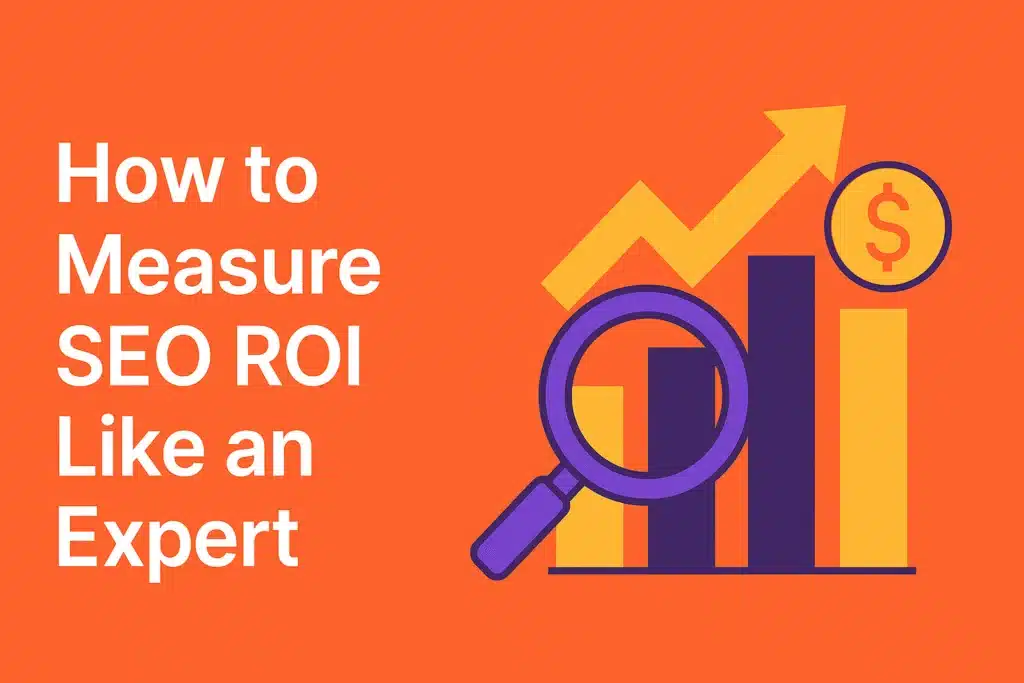Measuring SEO ROI is crucial for businesses that want to justify their marketing budget. Adults between 25 and 49 often weigh digital strategies carefully, so a clear plan for checking SEO return on investment helps them confirm which approaches support revenue growth. This post explains the best ways to track SEO results, measure SEO impact, and use trusted tools to see how well strategies are working.
What is SEO ROI and Why is it Important?
SEO ROI measures how revenue from search engine optimization compares with its costs. It combines traffic gains, conversions, and brand recognition into a single metric. Many businesses track this figure to assess the profit of their content, technical fixes, and link-building actions. A good SEO return on investment highlights that your marketing efforts are driving consistent business outcomes. By calculating this figure often, you can refine targeting, revise tactics, and stay in the game. This signal also shows how SEO aligns with bigger priorities, such as making qualified leads or e-commerce sales. Clear insights into SEO ROI improve ownership and encourage data-based decisions. Regular measurement keeps campaigns tuned for maximum gain.
What do we mean by SEO return on investment?
SEO return on investment compares the net gains from optimization efforts with the spending involved. “The ROI of SEO measures how much revenue SEO actions generate for a business compared to their cost” (Semrush). If revenue exceeds costs, you have a positive ROI. Regular check helps confirm the campaign’s value.
Why businesses must track SEO results regularly
Companies need to track SEO results regularly to identify strong and weak areas. Routine reviews display if pages are rising in rankings, getting more visitors, or making valuable leads. Frequent checks allow quick strategy updates. This approach shows success metrics and maintains progress in competitive markets. Ongoing tracking avoids surprises.
Key benefits of measuring SEO impact early
Measuring SEO impact early shows which tactics create quick gains. You can reassign resources faster and find quick wins before expanding bigger actions. “Typically, it can take 4-12 months to see the benefits of SEO, according to Google’s Maile Ohye” (Semrush). Early data builds the foundation for consistent improvements overall.
How to Measure SEO ROI Step by Step
Many businesses want a clear path to measure SEO ROI, beginning with defined goals and ending with revenue checks. First, determine which conversions matter most, whether they are lead captures or product sales. Next, gather relevant traffic data and assign money values to each action. Then, compare these figures with your monthly or annual SEO budget. By tracking organic growth over time, you can measure how your efforts yield real returns. You also need to analyze conversions that come from improved presence and user trust. Follow each step to see how SEO aligns with broader financial outcomes and refine your strategy. This approach clarifies performance and supports steady gains.
1. Set clear SEO goals linked to business outcomes
Clear SEO goals focus on actions that directly match to revenue or lead growth. “91% of B2B companies rely on content marketing campaigns to generate leads or raise brand awareness” (StoryChief). Align each target with consistent metrics, such as conversions or sign-ups, for real results. Goals drive priority and ownership.
2. Track your organic lead and traffic growth
Watch lead captures and traffic volume from search channels. “Organic search is a top traffic source for websites” (Semrush). Compare weekly or monthly changes in visitor counts to spot patterns. Tracking growth helps reveal which keywords or content pieces bring the most valuable users and potential sales. This improves focus.
3. Measure SEO-driven conversions and revenue
Record actions, such as sign-ups or sales, to see how optimization increases earnings. “Mainly, the ROI of SEO activities was as high as 1,389% over three years” (Surfer). Check each campaign’s revenue share and attribute it to the right keywords. Reliable conversion data reveals true profit sources. This clarifies patterns.
4. Compare SEO costs with earned returns
Add up expenses for internal teams, agency fees, content, and tools. Then compare these numbers to the revenue produced. “Organic search is a very profitable marketing channel that provides 53 percent of trackable website traffic” (seoClarity). This check reveals your net profit from SEO campaigns. Detailed cost tracking provides accuracy.
5. Calculate SEO ROI using a basic formula
Use a simple equation to measure gains: “ROI = (Value of Conversions – Investment) / Investment” (seoClarity). If your sales total $120,000 and your SEO costs are $20,000, the ROI is 5 times your spending. A higher factor shows better returns from your SEO strategy. This formula provides clear insights.
Tools to Track SEO Results and Performance
Relying on effective tools makes it easier to better monitor SEO achievements. Platforms like Google Analytics 4 and Google Search Console reveal traffic, top keywords, and user engagement. Specialized marketing suites, such as Semrush or Ahrefs, find backlink data, competitor insights, and ranking options. Conversion tracking tools record sign-ups, phone calls, or sales, tying outcomes to specific campaigns. These insights guide you to channel resources more effectively. You can learn which pages need optimization or which keywords drive profitable leads. With real-time updates, you see how changes impact your position. A balanced toolset helps you validate approaches and plan future steps. Accurate tracking protects resources and promotes consistent search growth.
Use Google Analytics 4 for real-time traffic tracking
Set up GA4 to see how visitors arrive and interact. “As of 2024, organic search continues to be a big source of website visits, accounting for about 33% of overall traffic” (SE Ranking). Check the real-time dashboard for conversions, bounce rates, and page performance. Segment data by medium to direct content.
Monitor rankings and keywords with Google Search Console
Access Google Search Console to spot ranking trends and find new keywords. “Google Search Console is one of the most strong SEO tools in the industry” (Databox). Watch click-through rates and query performance. Fix any indexing issues to keep pages visible in search results. Regular checks help refine keyword strategies.
Try marketing platforms like Ahrefs or SEMrush
Platforms such as Ahrefs and Semrush offer backlink study, traffic metrics, and competitor data. “Semrush is one of the most popular SEO tools on the market” (Backlinko). Check link quality, track organic growth, and analyze your competitors’ positions. In-depth insights guide planned changes for better SEO performance. They also make things easier.
Tag key actions properly with conversion tracking tools
Use conversion tracking to connect each click with important outcomes. “Google defines five main types of conversion actions to choose from when setting up conversion tracking” (WordStream). Mark form fills, calls, or purchases as conversions. Reviewing results helps refine bids, content placement, and SEO alignment. Prompt tagging stops missed data.
Conclusion
Tracking SEO ROI needs consistent study of traffic, conversions, and revenue. By setting clear goals, you assign real value to every visitor, lead, or sale. This approach turns data into tangible profit. Over time, your site can rank higher, attract more targeted traffic, and strengthen brand visibility. These outcomes save costs on paid ads and provide steady growth. With a calculated ROI figure, you also defend the resources spent on content, link building, or technical fixes. Ownership becomes clearer, and you can prove how SEO directly affects the bottom line. Keep checking metrics to keep momentum and find continued improvements. Regular review turns insights into useful changes, fast.
FAQs
What is considered a good SEO return on investment?
How do I track SEO results if I have low website traffic?
How does SEO ROI compare with paid ads ROI?
Can you measure long-term value in SEO ROI checks?
How often should I measure my site’s SEO impact?

Ridam Khare is an SEO strategist with 7+ years of experience specializing in AI-driven content creation. He helps businesses scale high-quality blogs that rank, engage, and convert.



